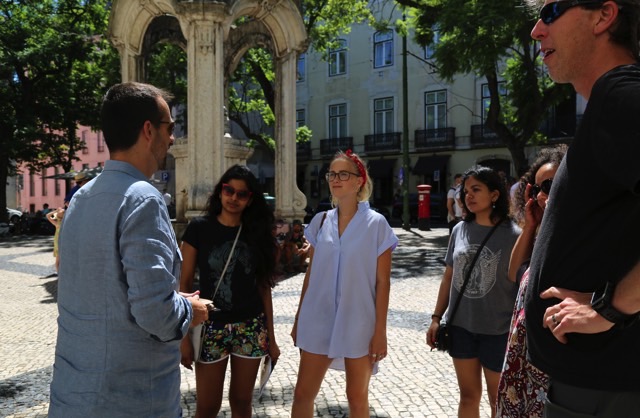Jill on assignment in Portugal
Jill Fernandes shares her experience as a winner of the 2019 Travel Writing Scholarship to Portugal.
On her first assignment as a travel writer, Jill discovers the magic of Sintra, sips port in Porto and learns what makes the fabric of a travel story.
My phone rang unexpectedly. It was Phil Sylvester, live from the World Nomads podcast. He had a rather strange question for me. “The priest in your story – just want to make sure you got a model release form from him?”
“Is that necessary?” I asked in confusion. I was still trying to remember the details of my story. Suspense was killing me.
Chuckling, he continued, “You are one of the three scholarship winners!”
Lisbon
A few months later, in Lisbon, I met the other winners, plus Rebecca Day from World Nomads, and Tim Neville, our mentor.
“How was your flight?” Tim asked.
“Four flights. 38 hours long,” I uttered, very jetlagged.
“Ah, that’s nothing for a travel writer,” he joked.
Our workshop days were action-packed. On day one, we reported and interviewed; day two, we nailed story structure; day three and four, we worked through pitches and the business of travel writing. Boiled eggs on toast for breakfast became our staple, while Pastel de nada, quaint Portuguese lunches, and a Fado dinner were interspersed with our writing workshop lessons. On day five, we dispersed, looking for our own stories.

Traveling through the countryside
I headed to Sintra, a UNESCO World Heritage Site known for its romantic architecture. I followed its mystical charms into the Quinta da Regaleira, a Gothic and Manuline-styled estate. Its spires glinted in the diminishing sunlight, while water dripped from gargoyles' mouths. I wandered from the Promenade of the Gods to the Portal of the Guardians, an impressive structure that hid a secret path to a Masonic initiation well.
Tim had stressed the importance of capturing details. I took it all in – marble arches and columns, narrow turrets, pointed spires. The sun began to set, and the sky fogged over, but the romance of this fairytale didn't fade.

When I finally pulled my head out of the clouds of Sintra, I pursued Portuguese history and culture. Driving through the countryside, we stopped at Arraiolos, historically famous for the art of rug making. But here, I found a different flavor of history. In the town square stood a tall beam with four protruding iron hooks.
Pointing at it, I asked naively, “What was that for?”
My guide responded, “Criminals were hung here for their crimes.”
What crime could be so bad, I thought, that the pain of complete social rejection should accompany death?
Trying to de-escalate my own thoughts, I joked, “Like witchcraft?”
He nodded, matter-of-factly.

Port-filled revelations
In Porto, I dined with Rafaela, from Turismo de Portugal and a well-traveled author. Sausages sizzled on the stone grill while we conversed about life, sipping aged Port. I asked about her travels and inspiration for writing. She told me her formula: “Creativity, novelty, culture, adventure, connection, and good food.” From this, the story weaves itself.
Tim's workshops, the magic of Sintra, the morbid iron beam of Arraiolos, and my Porto dinner with Rafaela were all elements she had just described. The formula had worked itself out.
In the midst of writing, days later, I reminisced about the experience that now felt like a dream. I frantically looked up the World Nomads site, just to check that it was real. And there it was – Phil's podcast, just as I remembered it.



